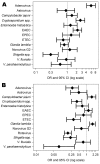Diarrheagenic pathogens in polymicrobial infections
- PMID: 21470448
- PMCID: PMC3377398
- DOI: 10.3201/eid1704.100939
Diarrheagenic pathogens in polymicrobial infections
Abstract
During systematic active surveillance of the causes of diarrhea in patients admitted to the Infectious Diseases and Beliaghata General Hospital in Kolkata, India, we looked for 26 known gastrointestinal pathogens in fecal samples from 2,748 patients. Samples from about one-third (29%) of the patients contained multiple pathogens. Polymicrobial infections frequently contained Vibrio cholerae O1 and rotavirus. When these agents were present, some co-infecting agents were found significantly less often (p = 10 (-5) to 10 (-33), some were detected significantly more often (p = 10 (-5) to 10 (-26), and others were detected equally as often as when V. cholerae O1 or rotavirus was absent. When data were stratified by patient age and season, many nonrandom associations remained statistically significant. The causes and effects of these nonrandom associations remain unknown.
Figures

Comment in
-
Viral and Bacterial Co-Infection and Its Implications.SciFed Virol Res J. 2017 Mar 28;1(1):10.23959/sfjv-1000002. doi: 10.23959/sfjv-1000002. SciFed Virol Res J. 2017. PMID: 29974891 Free PMC article. No abstract available.
References
-
- World Health Organization. Global burden of disease. Part 2. Causes of death [cited 2011 Feb 8]. http://www.who.int/healthinfo/global_burden_disease/GBD_report_2004updat...
-
- Chakraborty R, Sinha S, Mukhopadhyay AK, Asakura M, Yamasaki S, Bhattacharya SK, et al. Species-specific identification of Vibrio fluvialis by PCR targeted to the conserved transcriptional activation and variable membrane tether regions of the toxR gene. J Med Microbiol. 2006;55:805–8. 10.1099/jmm.0.46395-0 - DOI - PubMed
Publication types
MeSH terms
LinkOut - more resources
Full Text Sources
Medical
